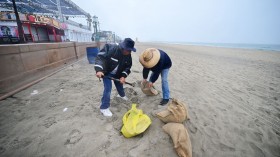Researchers from University of California, Davis are reporting the first case of swine flu (H1N1) found in marine mammals, providing further evidence of the virus' ability to move across species.
The virus that caused a 2009 pandemic has been reported in elephant seals living off the central California coast.
"We thought we might find influenza viruses, which have been found before in marine mammals, but we did not expect to find pandemic H1N1," said lead author Tracey Goldstein, an associate professor at UC Davis. "This shows influenza viruses can move among species."
H1N1 originated in pigs. It emerged in humans in 2009, spreading worldwide as a pandemic. The World Health Organization now considers the H1N1 strain from 2009 to be under control.
Researchers tracked a group of elephant seals after they left the California shores to travel north to forage.
"The seals on land in early 2010 tested negative before they went to sea, but when they returned from sea in spring 2010, they tested positive." Goldstein said. "So the question is where did it come from?"
Between 2009 and 2011, the team of scientists tested nasal swabs from more than 900 marine mammals from 10 different species off the Pacific Coast from Alaska to California. They detected H1N1 infection in two northern elephant seals and antibodies to the virus in an additional 28 elephant seals, indicating more widespread exposure. Oddly, the seals showed no signs of illness, leading the researchers to suspect that animals can have the virus without showing signs of infection.
The infected seals likely contracted H1N1 while they were at sea or upon entering a near-shore environment, the researchers reported. Because the seals were at sea during the interim, it is not suspected they contracted H1N1 from direct contact with humans.
Adolfo García-Sastre, of the Icahn School of Medicine at Mount Sinai in New York, said the find will potentially provide a better understanding of the H1N1 virus.
"The study of influenza virus infections in unusual hosts, such as elephant seals, is likely to provide us with clues to understand the ability of influenza virus to jump from one host to another and initiate pandemics," said García-Sastre
To avoid the possibility of infection, marine researchers are now being advised to wear protective gear when working around marine animals.
The research is published in the journal PLOS ONE.
© 2024 NatureWorldNews.com All rights reserved. Do not reproduce without permission.





